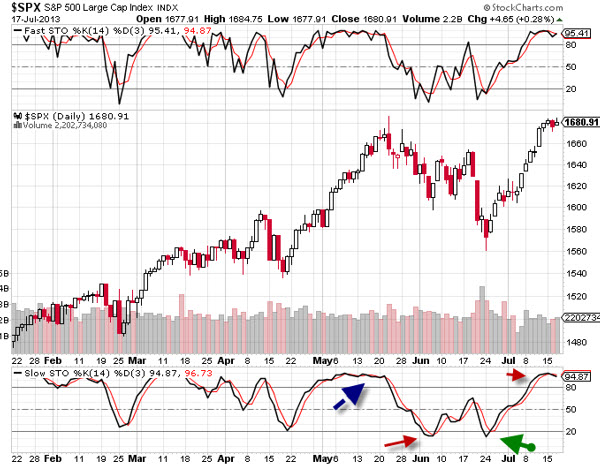[box type=”bio”]This is a guest post by Marcus Holland, editor of FinancialTrading.com[/box]
The stochastic oscillator is a momentum indicator developed by George Lane during the 1950’s. The indicator is used to follow momentum as it captures the closing price relative to the high-low range of an asset. The stochastic oscillator follows the rate of change of prices, and does not incorporate volume as part of its formula. The stochastic oscillator is used to find increasing momentum, as an overbought and oversold indicator, as well as to find divergences as momentum generally changes before changes in prices occur.
*The formula for the stochastic oscillator is:
[box type=”info”] “%K = (Current Close – Lowest Low)/ (Highest High – Lowest Low) * 100
%D = 3-day SMA of %K
Lowest Low = lowest low for the look-back period
Highest High = highest high for the look-back period
%K is multiplied by 100 to move the decimal point two places
Lane created a default for the Stochastic Oscillator which was 14 periods. A 14-period %K would use the most recent close, the highest high over the last 14 periods and the lowest low over the last 14 periods. %D is a 3-day simple moving average of %K.”[/box]
The fast stochastic oscillator measures the currency price relative to the high and low values over the defined period and generates an index from that information. The fast stochastic is the one created by Lane, and variations have been made to create a smoother oscillator known as the slow stochastic oscillator. The slow stochastic oscillator changes the %K with a 3-day simple moving average, which is exactly what %D is in the Fast Stochastic Oscillator. The %D is then smoothed as it becomes the 3-day moving average of the 3-day moving average.
Trading Strategies with Stochastic Oscillator
There are three distinct strategies that can be used to invest using stochastic: a momentum crossover strategy, an overbought and oversold technique, and a divergence methodology.
SPX chart with Stochastic Oscillator [courtesy of Stock Charts]
- One of the most popular ways to use slow stochastic is using a momentum crossover strategy. This occurs when the %K crosses above or below the %D. When it crosses above, a buy signal is generated and when it crosses below a sell signal is generated (red arrows). Each signal is telling a trader that momentum is turning and price action will follow.
- Many traders also use stochastic as overbought and oversold indicators. When the index moves above the 80 index level a security is considered overbought. When the index moves below the 20 level the security is considered oversold (green arrow). Although securities can remain overbought or oversold for a while, the index provides a guide for a potential reversal.
- A third technique used is stochastic oscillator divergence. This occurs when prices continue to rise and the stochastic is moving in the opposite direction. Although prices continue to move higher (blue arrow), a divergence occurs when momentum begins to move lower.
Stochastic is an excellent tool for traders to use to measure a combination of momentum as well as, periods when a security is poised to diverge.

Comments (No)